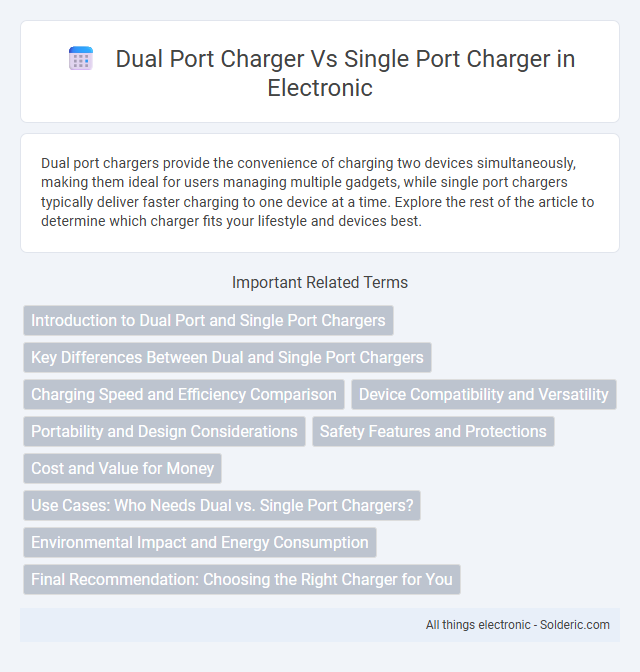Dual port chargers provide the convenience of charging two devices simultaneously, making them ideal for users managing multiple gadgets, while single port chargers typically deliver faster charging to one device at a time. Explore the rest of the article to determine which charger fits your lifestyle and devices best.
Comparison Table
| Feature | Dual Port Charger | Single Port Charger |
|---|---|---|
| Number of Devices Supported | 2 simultaneous devices | 1 device at a time |
| Charging Speed | Moderate per port, may vary with load | Optimized full power to single device |
| Port Types | Often USB-A + USB-C or dual USB-C | Usually USB-A or USB-C |
| Power Output | Typically 18W-36W total | Commonly 18W-30W per port |
| Convenience | Charge multiple devices simultaneously | Simple, dedicated charging for one device |
| Cost | Generally higher than single port | Usually more affordable |
| Portability | Slightly larger due to extra port | Compact and lightweight |
Introduction to Dual Port and Single Port Chargers
Dual port chargers allow simultaneous charging of two devices through separate ports, increasing convenience and efficiency compared to single port chargers that support only one device at a time. Single port chargers are often more compact and simpler, making them ideal for minimal usage or travel. Your choice depends on whether you prioritize charging multiple gadgets at once or prefer a lightweight, straightforward solution.
Key Differences Between Dual and Single Port Chargers
Dual port chargers offer the convenience of charging two devices simultaneously, often featuring higher combined output wattage compared to single port chargers which provide power to only one device at a time. Single port chargers typically deliver a focused, stable current that is beneficial for high-efficiency charging of a single device, whereas dual port chargers may slightly reduce the output per port when both are in use. The choice between dual and single port chargers depends on the user's need for multi-device charging versus dedicated charging speed and efficiency.
Charging Speed and Efficiency Comparison
Dual port chargers enable simultaneous charging of two devices, which can reduce overall charging time compared to single port chargers that power only one device at a time. However, the charging speed per port on dual port chargers may be lower if the total output current is split between the two ports, affecting efficiency. Single port chargers often provide dedicated maximum power output, resulting in faster charging speeds for one device without sharing the current load.
Device Compatibility and Versatility
Dual port chargers enhance device compatibility by allowing simultaneous charging of multiple gadgets, including smartphones, tablets, and laptops, without compromising power output. Your convenience increases as these chargers support diverse charging standards like USB-C Power Delivery and Quick Charge, making them versatile for various devices. Single port chargers often limit versatility due to their single output and compatibility with fewer charging protocols.
Portability and Design Considerations
Dual port chargers offer enhanced portability by combining multiple charging ports into a single compact unit, reducing the need to carry multiple chargers when traveling. Their design incorporates efficient power management and heat dissipation systems, ensuring safe simultaneous charging of devices while maintaining a lightweight and space-saving profile. Single port chargers may be smaller but require multiple units for multiple devices, which can increase bulk and complicate packing for on-the-go use.
Safety Features and Protections
Dual port chargers often include advanced safety features such as overcurrent protection, temperature control, and short-circuit prevention to ensure safe simultaneous charging of multiple devices. Single port chargers usually provide basic safeguards but may lack the enhanced protections found in dual port models designed to manage higher power output. When choosing a charger, your priority should be features that prevent overheating, voltage spikes, and electrical surges to protect both your charger and connected devices.
Cost and Value for Money
Dual port chargers typically offer greater value for money by allowing simultaneous charging of two devices, reducing the need to buy multiple chargers. While single port chargers are usually cheaper upfront, investing in a dual port charger can save you money long-term by minimizing the number of accessories and offering more convenience. Your overall cost efficiency improves as dual port chargers handle more tasks with just one power outlet, making them a smarter choice for budget-conscious users.
Use Cases: Who Needs Dual vs. Single Port Chargers?
Dual-port chargers are ideal for users who need to charge multiple devices simultaneously, such as smartphones and tablets, making them perfect for travelers, families, or office settings. Single-port chargers suit individuals with minimal charging needs or those looking for a compact solution for one device. Your choice depends on whether you prioritize convenience and multitasking or simplicity and portability.
Environmental Impact and Energy Consumption
Dual port chargers reduce environmental impact by consolidating multiple device inputs into a single unit, minimizing electronic waste compared to purchasing separate single port chargers. Energy consumption is often more efficient with dual port chargers, as they share internal components and power management systems, leading to reduced standby power draw. Using a dual port charger can lower overall carbon footprint by decreasing the number of chargers produced, shipped, and discarded.
Final Recommendation: Choosing the Right Charger for You
Choosing the right charger depends on your device usage and charging habits; dual port chargers provide the advantage of charging two devices simultaneously, saving time and reducing the need for multiple outlets. Single port chargers are often more compact, cost-effective, and ideal for users with minimal charging needs or limited space. Your decision should balance convenience, power requirements, and portability to match your daily routine efficiently.
Dual port charger vs single port charger Infographic

 solderic.com
solderic.com